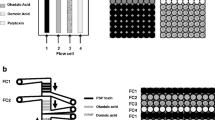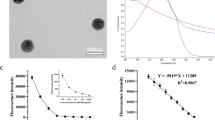Abstract
The mouse bioassay is the methodology that is most widely used to detect okadaic acid (OA) in shellfish samples. This is one of the best-known toxins, and it belongs to the family of marine biotoxins referred to as the diarrhetic shellfish poisons (DSP). Due to animal welfare concerns, alternative methods of toxin detection are being sought. A rapid and specific biosensor immunoassay method was developed and validated for the detection of OA. An optical sensor instrument based on the surface plasmon resonance (SPR) phenomenon was utilised. A polyclonal antibody to OA was raised against OA–bovine thyroglobulin conjugate and OA–N-hydroxy succinimide ester was immobilised onto an amine sensor chip surface. The assay parameters selected for the analysis of the samples were: antibody dilution, 1/750; ratio of antibody to standard, 1:1; volume of sample injected, 25 μl min−1; flow rate, 25 μl min−1. An assay action limit of 126 ng g−1 was established by analysing of 20 shellfish samples spiked with OA at the critical concentration of 160 ng g−1, which is the action limit established by the European Union (EU). At this concentration of OA, the assay delivered coefficient of variations (CVs) of <10%. The chip surface developed was shown to be highly stable, allowing more than 50 analyses per channel. When the concentrations of OA determined with the biosensor method were compared with the values obtained by LC–MS in contaminated shellfish samples, the correlation between the two analytical methods was found to be highly satisfactory (r 2 = 0.991).

Biacore

Similar content being viewed by others
References
Yasumoto T, Oshima Y, Yamaguchi M (1978) Bull Japan Soc Sci Fish 44:1249–1255
Yasumoto T, Murata M, Oshima Y, Sano M, Matsumoto GK, Clardy J (eds)(1984) Seafood toxins (ACS Symp Ser 262). American Chemical Society, Washington, DC
Terao K, Ito E, Ohkusu M, Yasumoto T (1993) In: Smayda TJ, Shimizu Y (eds) Toxic phytoplankton blooms in the sea. Elsevier, Amsterdam
McNabb P, Holland P, van Ginkel R, Selwood A (2004) In: Book of abstracts from the 5th Int Conf on Molluscan Shellfish Safety, 14–18 June 2003, National University of Ireland, Galway
Takagi T (1984) Bull Japan Soc Sci Fish 50(8):1413–1418
Lawrence JF, Chadha RK, Ratnayake WM, Truelove JF (1994) Nat Toxins 2:318–321
EC (2002) Commission Decision 2002/225/EC of 15 March 2002 laying down detailed rules for the implementation of Council Directive 91/492/EEC as regards the maximum levels and the methods of analysis of certain marine biotoxins in bivalve mollusc, echinoderms, tunicates and marine gastropods. Off J Eur Commun L75:62–66
EC (1986) Council Directive 86/609/EEC of 24 November 1986 on the approximation of laws, regulations and administrative provisions of the Member States regarding the protection of animals used for experimental and other scientific purposes. European Communities, Brussels
Ramstad H, Shen JL, Larsen S, Aune T (2001) Toxicon 39:1387–1391
Nogueiras MJ, Gago-Martínez A, Paniello AI, Twohig M, James KJ, Lawrence JF (2003) Anal Bioanal Chem 377:1202–1206
Rossini GP (2005) Toxicology 207:451–462
Nishiwaki S, Fujiki H, Suganuma M, Furuya-Suguri H, Matsushima R, Iida Y, Ojika M, Yamada K, Uemura D, Yasumoto T, Schmitz FJ, Sugimura T (1990) Carcinogenesis 11:1837–1841
Holmes CFB (1991) Toxicon 29:469–477
Mountfort DO, Suzuki T, Truman P (2001) Toxicon 39:383–390
Rossini GP (eds)(2000) Seafood and freshwater toxins. Marcel Dekker, New York, pp 257–288
Leira F, Alvarez C, Cabado AG, Vieites JM, Vieytes MR, Botana LM (2003) Anal Biochem 317:129–135
Kreuzer NP, Pravda M, O’Sullivan CK, Guilbault GG (2002) Toxicon 40:1267–1274
Tang AXJ, Pravda M, Guilbault GG, Piletsky S, Turner APF (2002) Anal Chim Acta 471:33–40
Gaudin V, Fontaine J, Maris P (2001) Anal Chim Acta 436:191–198
Gaudin V, Cadieu N, Sanders P (2005) Anal Chim Acta 529(1–2):273–283
Gustavsson E, Bjurling P, Degelaen J, Sternesjö Å (2002) Food Agr Immunol 14:121–131
Ferguson JP, Baxter GA, McEvoy JDG, Stead S, Rawlings E, Sharman M (2002) Analyst 127:951–956
Haasnoot W, Loomans E, Cazemier G, Dietrich R, Verheijen R, Bergwerff AA, Stephany RW (2002) Food Agr Immunol 14:15–27
Mauriz E, Calle A, Abad A, Montoya A, Hildebrandt A, Barceló D, Lechuga LM (2006) Biosens Bioelectron 21:2129–2136
Mello LD, Kubota LT (2002) Food Chem 77:237–256
Traynor IM, Plumpton L, Fodey TL, Higgins C, Elliott CT (2006) J AOAC Int 89:868–873
McCarron P, Emteborg H, Hess P (2007) Anal Bioanal Chem 387:2475–2486
Usleber E, Schneider E, Terplan G (1991) Lett Appl Microb 13:275–277
Park DL (1995) J AOAC Inter 78:533–537
Carmody EP, James KJ, Kelly SS (1995) J AOAC Inter 78:1403–1408
Tachibana K, Scheuer PJ, Tsukitani Y, Kikuchi H, van Eugen D, Clardy J, Gopichand Y, Schmitz FJ (1981) J Am Chem Soc 103:2469–2471
Takai A, Murata M, Torigoe K, Isobe M, Mieskes G, Yasumoto T (1992) J Biochem 284:539–544
Cooper J, Elliott CT, Baxter A, Hewitt SA, McEvoy JDG, McCaughey J (1998) Food Agr Immunol 10:133–142
Acknowledgements
We thank the European project under the Sixth Framework Programme Priority 5 Food Quality and Safety (Contract No.: Detectox, 514055) for funding.
Author information
Authors and Affiliations
Corresponding author
Rights and permissions
About this article
Cite this article
Llamas, N.M., Stewart, L., Fodey, T. et al. Development of a novel immunobiosensor method for the rapid detection of okadaic acid contamination in shellfish extracts. Anal Bioanal Chem 389, 581–587 (2007). https://doi.org/10.1007/s00216-007-1444-3
Received:
Revised:
Accepted:
Published:
Issue Date:
DOI: https://doi.org/10.1007/s00216-007-1444-3




